牛津译林版七年级英语下册Unit5 Grammar教案-新版
【新】牛津译林版七年级英语下册Unit5 Grammar教案

Unit5 Grammar教案【学习目标】1.掌握一般过去时的用法并能熟练使用2. 规则动词+ed 后的读音和不规则动词过去式的变化【预习导学】1.这部分出现了几个新单词,你知道怎么写,怎么读吗?以前________ 前天________ 厘米________渡渡鸟________2.你还知道哪些表示过去的时间?__________________ ____________________ _____________ _ __________________ ____________________ _____________ _ 3.当我们谈论过去的事情时,我们用一般过去时。
大家是否观察到动词在过去时中的变化呢?你所理解的一般过去时,举例说明:___________________________________________________ _【课堂展示】(一)预习情况交流(1)(二)展示交流1.下面的这三个时间分别表示什么?20022015 2028________________________我们用_____________ 谈论_____________我们用__一般现在时谈论_____________我们用_____________ 谈论__将来___________2. 你知道有哪些表示时间的短语?(预习2)3. 一般过去式的动词变化。
◆这些词想变身,你能把他们变成-ed形式吗?(单独完成)search__________ sound__________ play__________pick__________ love__________ carry__________start__________ use__________ chat__________◆回头看看你所变化后的词尾,你发现规律了吗?(小组合作完成)构成规则原形过去式一般在动词原形末尾加__________workplay____________________结尾是e的动词加__________hopelive____________________末尾只有一个__________的重读闭音节词,先_________ _,再加_______stoptrip____________________结尾是“辅音字母+_____”的动词,先变“_____”为“_____”再加________ studyworry____________________读音规则读音例词在浊辅音和元音后面moved /mu:vd/Cleaned listened在清辅音后面()passed /pa:st/ helpedasked, finished/watched在t, d后面needed /’ni:did/started◆练一练书本P62的Part A.(单独完成-个别展示)◆动词过去式的变化并不都是规则的,也有不规则的,看:_________ _,如:cost ---__________ put----__________ let---________________ ___,如:come-- _________write --_________ring--__________know –___________________ ,如:make--__________ spend --__________ send --__________ build—__________ _________ _,如:do--__________ see---__________ have--__________ find---__________◆刚才的不规则动词过去式变化你都记住了吗?挑战一下吧(单独完成—组内核对答案)go_________ get_________ give_________ take_________spend_________ see_________ have_________ tell_________◆完成P62 Part B(全班展示)◆完成P62 Part C(全班展示)◆你能找出这两篇里的重点短语吗?互相交流交流。
牛津译林版英语七年级下册Unit5 Grammar精品教案
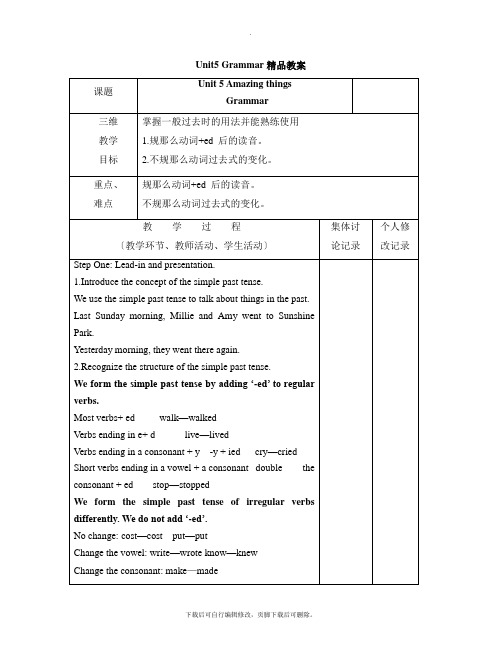
spend—spentChange the vowel(s) and the consonant(s):leave—leftcatch—caughtStep Two:Presentation:
④Same opened the door and ____(see) a nice dog.
⑤Danny_____(leave)homewhen he was attheage of15.
⑥Mike __________(go) to the park with his sisterlast week.
集体讨
论记录
个人修改记录
Step One: Lead-in and presentation.
1.Introduce the concept of the simple past tense.
We use the simple past tense to talk about things in the past.
+ ed
walk→walked
Verbs endingin e
+ d
live→lived
Verbs ending in a consonant +y
-y + ied
study→studied
Short verbs ending in a vowel + a consonant
double the
consonant + ed
stop→stopped
最新牛津译林版中学七年级英语下册 Unit 5 Amazing things Grammar教案 (3)
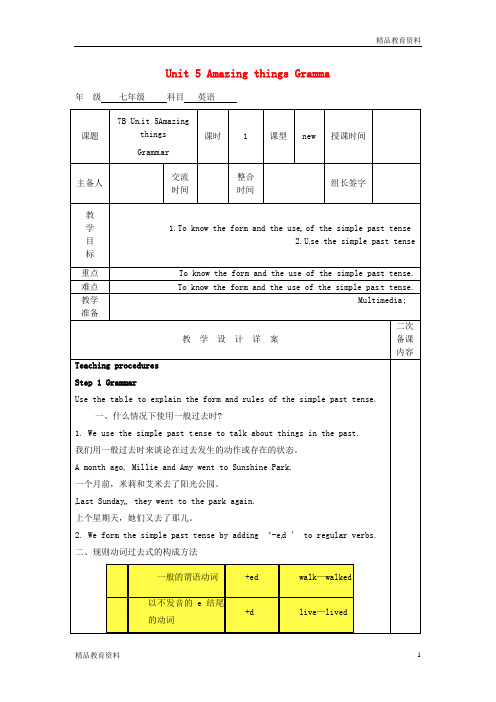
Unit 5 Amazing things Gramma 年级七年级科目英语课题7B Un it 5AmazingthingsGramm ar课时 1 课型new 授课时间主备人交流时间整合时间组长签字教学目标1.To know the form and the use of the simple past tense2.U se the simple past tense重点.m and the use of the simple past tenseTo know the for难点.t tenseTo know the form and the use of the simple pas教学准备Multimedia;教学设计详案二次备课内容Teaching proceduresStep 1 GrammarUse the tab le to explain the form and rules of the simple past tense.一、什么情况下使用一般过去时?1. We use the simple past t ense to talk about things in the past.我们用一般过去时来谈论在过去发生的动作或存在的状态。
A month ago, Millie and Amy went to Sunshine Park.一个月前,米莉和艾米去了阳光公园。
Last Sunday, they went to the park again.上个星期天,她们又去了那儿。
2. We form the simple past tense by adding ‘-e d ’ to regular verbs.二、规则动词过去式的构成方法1 一般的谓语动词+ed walk—walked2 以不发音的e结尾的动词+d live—lived3 以辅音字母+y结尾的动词变y为iedcry—cried4 以一个元音字母+一个辅音字母结尾的短动词双写末尾的辅音字母+edstop—stopped三、不规则动词的过去式不是加ed 构成的,需要我们记住它们。
unit5 Grammar2 课时教案牛津译林版七年级英语下册
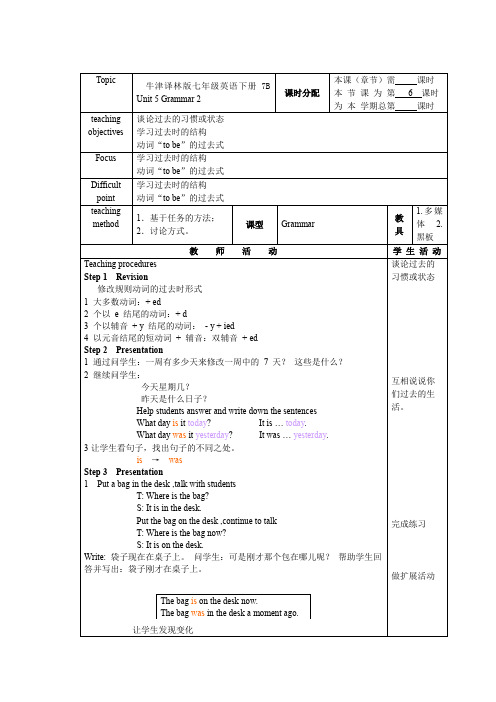
(1) We use 'was' when the subject is __(I).__ (he), __ (she) or __ (it).
We use 'were' when the subject is___(you), __ (we) or __ (they).
The bagison the desk now.
The bagwasin the desk a moment ago.
让学生发现变化
2要求学生组成类似的对话。记住使用“is”和“was”
例如,A:我的书现在在哪里?B:它在你的桌子上。
A:可是刚才它在哪儿呢?B:它在你的左手上。
3用同样的方法引出
4重复步骤2。练习使用。
学习过去时的结构
动词“to be”的过去式
teaching method
1.基于任务的方法;
2.讨论方式。
课型
Grammar
教具
1.多媒体2.黑板
教师活动
学生活动
Teaching procedures
Step 1 Revision
修改规则动词的过去时形式
1大多数动词:+ ed
2个以e结尾的动词:+ d
(2) Negative structures of the verb 'to be in simple past tense are:
I/He/She/It __ /___...(was not wasn't)
We/You/They __ /___... (were not weren't)
让学生发现变化
初中英语七年级下册(牛津译林版)Unit5Grammar说课稿
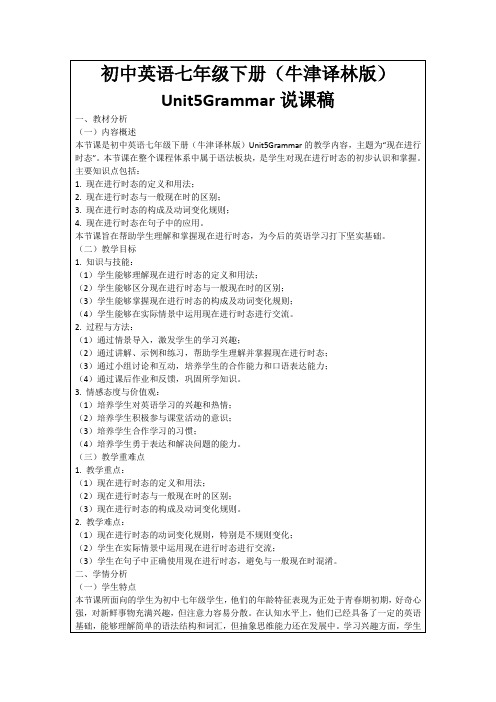
4.结合学生的兴趣点,如流行文化、体育活动等,设计相关话题的练习,使学习内容更贴近学生的生活,提高学习兴趣;
5.给予学生及时的反馈和肯定,鼓励他们在学习过程中积极尝试和表达,增强自信心。
三、教学方法与手段
(一)教学策略
(二)学习障碍
在学习本节课之前,学生可能已经接触过一般现在时态,对一般现在时的构成和用法有一定的了解,但对现在进行时态可能较为陌生。前置知识方面,学生需要具备一定的词汇量和基本的语法知识,如动词的现在分词形式。可能存在的学习障碍包括:
1.对现在进行时态的概念理解不清晰,容易与一般现在时混淆;
2.对动词的现在分词变化规则掌握不牢固,尤其是不规则变化;
2.现在进行时态与一般现在时的区别;
3.现在进行时态的构成及动词变化规则;
4.现在进行时态在句子中的应用。
本节课旨在帮助学生理解和掌握现在进行时态,为今后的英语学习打下坚实基础。
(二)教学目标
1.知识与技能:
(1)学生能够理解现在进行时态的定义和用法;
(2)学生能够区分现在进行时态与一般现在时的区别;
五、板书设计与教学反思
(一)板书设计
我的板书设计注重清晰性、简洁性和结构性。板书布局分为三个部分:标题区、内容区和总结区。标题区位于黑板顶部,清晰地标明本节课的主题“现在进行时态”。内容区是板书的核心部分,包括现在进行时态的定义、构成、用法以及与一般现在时的区别。我会使用不同颜色的粉笔来区分不同知识点,增强视觉效果。总结区位于黑板底部,用于总结本节课的重点和难点。
(3)学生能够掌握现在进行时态的构成及动词变化规则;
(4)学生能够在实际情景中运用现在进行时态进行交流。
牛津译林版英语七年级下册Unit5教案教学设计

2.学生用自己的话复述课堂所学,加深印象。
3.教师强调本节课的重点和难点,提醒学生课后加强练习。
4.布置课后作业,巩固所学知识,并拓展延伸。
5.鼓励学生在日常生活中多观察、多思考,用英语记录有趣的事情,培养良好的英语学习习惯。
4.口语作业:与家人或朋友进行英语对话,主题为“my hobbies and daily routines”,每人至少用到一个目标词汇和一般现在时、现在进行时的句子。
5.写作练习:围绕本节课的话题,写一篇小短文,介绍自己的兴趣爱好和日常活动,不少于80词。
6.观察日记:用英语记录一周内自己觉得有趣的事情,要求至少用到3个目标词汇和一般现在时、现在进行时的句子。
在本章节的学习中,学生面临的主要挑战是如何运用所学词汇和句型进行真实语境的交流,以及如何正确运用时态描述动作和状态。为此,教师应关注以下几点:
1.针对学生英语水平参差不齐的现状,设计分层教学活动,使每个学生都能在原有基础上得到提高。
2.通过丰富的课堂活动,激发学生的学习兴趣,帮助他们树立自信心,克服心理障碍,勇于开口表达。
五、作业布置
为了巩固本章节所学知识,提高学生的英语应用能力,特布置以下作业:
1.词汇练习:完成教材课后练习中的词汇填空题,要求学生在规定时间内完成,并自查错误。
2.句型练习:根据本节课所学的句型,编写至少5个句子,描述自己或家人的兴趣爱好和日常活动,注意运用一般现在时和现在进行时。
3.阅读理解:阅读教材中的相关文章,完成文章后的练习题,提高阅读理解能力。
3.互动交流,提高口语:鼓励学生进行小组合作、讨论、分享,提高他们的口语表达能力,培养良好的交际习惯。
4.巧用多媒体,辅助教学:利用多媒体教学资源,如图片、视频、音频等,帮助学生更好地理解和记忆词汇、句型和语法知识。
牛津译林版英语 七年级下册 Unit 5 Amazing things Grammar Simpl
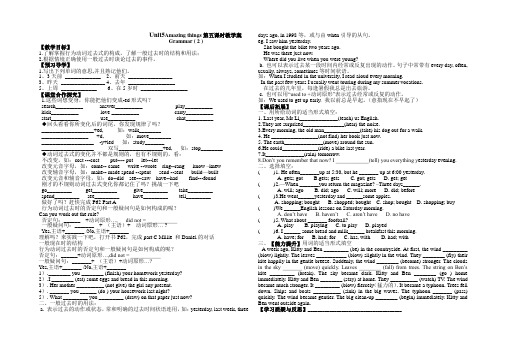
Unit5Amazing things第五课时教学案Grammar ( 2 )【教学目标】1.了解掌握行为动词过去式的构成,了解一般过去时的结构和用法;2.根据情境正确使用一般过去时谈论过去的事件。
【预习导学】1.写出下列单词的意思,并且熟记他们。
1、3天前_____________2、前天________________3、昨天________________4、去年_________________5、上周_____________6、在5岁时_________________【课堂合作探究】1.这些词想变身,你能把他们变成-ed形式吗?search__________ answer__________ play__________kick__________ love __________ carry__________start__________ use__________ chat__________◆回头看看你所变化后的词尾,你发现规律了吗?___________________+ed, 如:walk_________________________ +d, 如:move___________________________ -y+ied 如:study__________________________ 双写________________+ed, 如:stop________◆动词过去式的变化并不都是规则的,也有不规则的,看:不改变,如:cost ---cost put---- put let---let改变元音字母,如:come-- came write --wrote ring--rang know –knew改变辅音字母,如:make-- made spend --spent send --sent build—built改变元音和辅音字母,如:do--did see---saw have--had find---found刚才的不规则动词过去式变化你都记住了吗?挑战一下吧go_________ get_________ give_________ take_________spend_________ see_________ have_________ tell_________做好了吗?赶快完成P62 Part A行为动词过去时的否定句和一般疑问句是如何构成的呢?Can you work out the rule?否定句:______ +动词原形…, did not = ___________一般疑问句:_______ + (主语)+ 动词原形… ?Yes,主语+_______ /No,主语+_______理解吗?来实践一下吧,打开书P62,完成part C Millie 和Daniel的对话一般现在时的结构行为动词过去时的否定句和一般疑问句是如何构成的呢?否定句:______+动词原形…,did not = ___________一般疑问句:_______+ (主语)+动词原形…?Yes,主语+_______ /No,主语+_______1).________ you ________ (finish) your homework yesterday?2).I ________ (eat) some eggs and bread in this morning.3). Her mother __________ (not give) the girl any present.4). _______ you ______ (do ) your housework last night?5). What _________ you _________ (draw) on that paper just now?二、一般过去时的用法:a. 表示过去的动作或状态,常和明确的过去时间状语连用,如:yesterday, last week, three days ago, in 1998等,或与由when引导的从句。
新牛津译林版英语七年级下册第五单元grammar教案
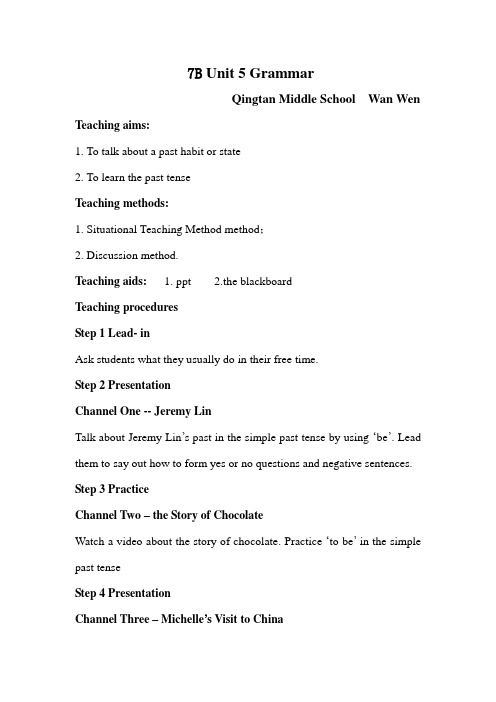
7B Unit 5 GrammarQingtan Middle School Wan Wen Teaching aims:1. To talk about a past habit or state2. To learn the past tenseTeaching methods:1. Situational Teaching Method method;2. Discussion method.Teaching aids: 1. ppt 2.the blackboardTeaching proceduresStep 1 Lead- inAsk students what they usually do in their free time.Step 2 PresentationChannel One -- Jeremy LinTalk about Jeremy Lin’s past in the simple past tense by using ‘be’. Lead them to say out how to form yes or no questions and negative sentences. Step 3 PracticeChannel Two – the Story of ChocolateWatch a video about the story of chocolate. Practice ‘to be’ in the simple past tenseStep 4 PresentationChannel Three – Michelle’s Visit to China1. Show some pictures of Michelle’s Visit to China. Let students try to work out the rules about how to form the past forms of ‘to do’2. Show examples of past formStep 5 PracticeChannel Four – the Growth of Meilun and Meihuan1. Lead them to say out how to form yes or no questions and negative sentences with the past form of ‘to do’2. Short dialogue about what your mum did for youStep 6 EvaluationChannel Five -- the Story of you and your mother1.Work in a group of four to talk about the story, remind them to usesimple past tense.2.Share the story to the classStep 7 Homework。
牛津译林版七年级下Unit5 Grammar课件(共34张PPT)
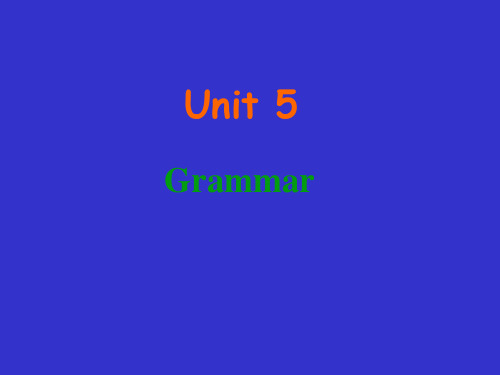
• stand_s_t_o_o_d___ looklo__o_k_e_d___ • is _w__a_s____ come _c_a_m_e____ • search _s_e_a_rc_h_e_d_ find _fo_u_n_d____
only 11 centimeters tall. • Daniel: That’s amazing! What else? • Millie: We alsole_a_r_n_t_/l_e_a_rn_e__d_(learn) about
some strange birds like dodolsiv. eTdhey ______(live) on the earth a long time ago. • Daniel: That’s cool.
Complete Part C on Page 62.
• Millie: We _w_e_n__t (go) to the Fun World Museum the day before yesterdawy,aDsaniel. It _____(be) so interesting.
• Daniel: Really? Tell me all about it. • Millie: OK. We _s_a_w__(see) a small monkey,
• 改为否定句:It wasn’t strange.be+not
• 改为一般疑问句:Was it strange? • 作肯定回答:Yes, it was. 将be提到句首 • 作否定回答:No, it wasn’t.
找规律
• They heard a whisper. • 改为否定句:They didn’t hear a whisper. • 改为一般疑问句:Did they hear a whisper? • 作肯定回答:Yes,they did. • 作否定回答:No,they didn’t. • 对划线部分提问:What did they hear?
七年级英语下册 Unit 5 Abilities Grammar教案 牛津版
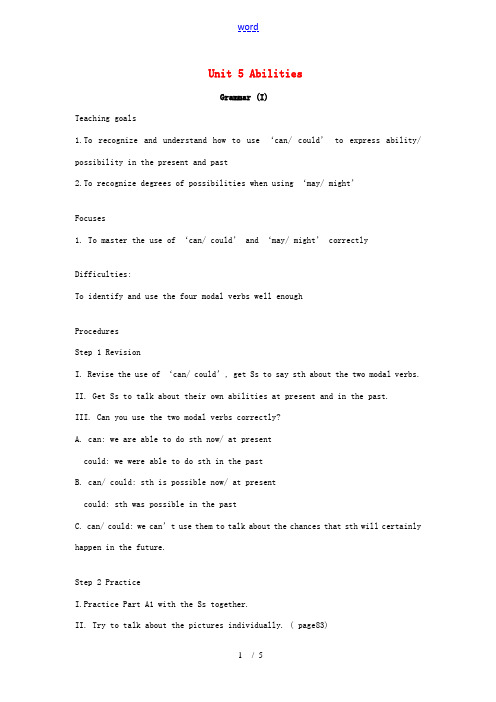
Unit 5 AbilitiesGrammar (I)Teaching goals1.To recognize and understand how to use ‘can/ could’ to express ability/ possibility in the present and past2.To recognize degrees of possibilities when using ‘may/ might’Focuses1. To master the use of ‘can/could’ and ‘may/ might’ correctlyDifficulties:To identify and use the four modal verbs well enoughProceduresStep 1 RevisionI. Revise the use of ‘can/ could’, get Ss to say sth about the two modal verbs. II. Get Ss to talk about their own abilities at present and in the past.III. Can you use the two modal verbs correctly?A. can: we are able to do sth now/ at presentcould: we were able to do sth in the pastB. can/ could: sth is possible now/ at presentcould: sth was possible in the pastC. c an/ could: we can’t use them to talk about the chances that sth will certainly happen in the future.Step 2 PracticeI.Practice Part A1 with the Ss together.II. Try to talk about the pictures individually. ( page83)III. Help Ss to find out they are great because they can do so many things in their daily life. They have healthy bodies and minds. They can do so many things. So we should be grateful to our parents for giving us so many things in the world. IV. Ss practice page 84 Part B individually.Step 3 ProductionSs finish off the sentences using the modal verbs.1. School finishes at 4 p.m. The bus leaves at 4.10 p.m. We _______ take the bus.2. It will be warm tomorrow so we________ wear short sleeves.3. I _______ play games on my old puter, but the new one is much faster.4. I forgot my key. I ________ open the door.Grammar (II)Difficulties:To use the two kinds of ways to talk about future fluentlyProceduresStep 1 Presentation1. Arouse Ss’ interest in how to praise Zhang Hua with strong feelings in Chinese or English.2. Lead into the new item: to use the Imperative Sentences to express strong feelings. Sum up Ss’ answers on the Bb.A.What + a/ an + adj + sb/ sth(单数) +(S + V)!What + + adj + sb/ sth(复数) +(S + V)!What + + adj + sb/ sth(不可数名词) +(S + V)!B. How + adj/ adv (+ S+ V)!Step 2 PracticeI. Give Ss some words, get Ss to join them together.1. flowers, beautiful. What, are, they!2. interesting, what, an, book, is, it!3. nice, a, day, what, today, is!4. news, surprising, what, they, watching, are5. strong, the, man, a, what, he, is!6. weather, fine, what, it, is!7.What beautiful flowers they are!8. What an interesting book it is!9. What a nice day it is!10. What surprising news they are watching!11. What a strong man he is!12. What fine weather it is!II. Do the same things as the same way above.1. flowers, beautiful. how, are, the!2. interesting, how, this, book, is!3. nice, today, how, is!4. news, surprising, how, the, is!5. strong, the, man, how, is!6. today, fine, how it, is!7.How beautiful the flowers are!8.How interesting this book is!9.How nice today is!10. How surprising the news is!11. How strong the man is!12. How fine it is today!Step 3 Practice1. Talk about the pictures on page 85 Part C. Individuals give their answers. 1. What beautiful flowers!How wonderful the flowers are!2. How wonderful!What a wonderful program!3. What a big fire!How big the fire is!4. What a brave young man!How brave the young man is!5. How dangerous the fire is!2. Make more able Ss to give their own sentences in class.Step 4 ProductionFinish off the conversation in pairs.A. Do you know about Zhang Hua?B: Yes, Of course. He helped his neighbour out of a fire.A: _______ brave he was! We should _________ from him.B: I ______ with you. If you e across this kind of things.________ you be so brave like him?A: I think I _________ also do the same thing.B: _______ a brave boy you will be! We should try our best ______ others.Step 5 Homework1. Go over Integrated skills after class.2. Make up some sentences using the simple future tense as written work.。
Unit 5 Grammar B课时教案牛津译林版七年级英语下册
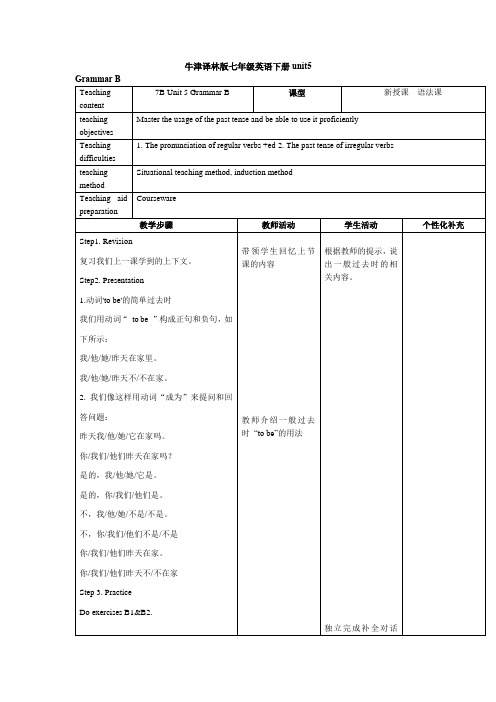
5. I arrive at school more than about 7:00 every day.
6. Why was he angry with you at the time?
Step 5..Homework
1.完成练习本。
我/他/她/昨天不/不在家。
2.我们像这样用动词“成为”来提问和回答问题:
昨天我/他/她/它在家吗。
你/我们/他们昨天在家吗?
是的,我/他/她/它是。
是的,你/我们/他们是。
不,我/他/她/不是/不是。
不,你/我们/他们不是/不是
你/我们/他们昨天在家。
你/我们/他们昨天不/不在家
Step 3. Practice
typography design
Unபைடு நூலகம்t 5Grammar B
Was I/he/she/it at home yesterday.
Were you/we/they at home yesterday.
Yes, I/he/she/it was .
Yes, you/we/they were.
No, I/he/she/it was not / wasn’t.
2.背诵动词“to be”的一般过去时。
带领学生回忆上节课的内容
教师介绍一般过去时“to be”的用法
用书上的两个练习来检测学生的学习情况。
用翻译题来进行实战演练。
根据教师的提示,说出一般过去时的相关内容。
独立完成补全对话题,积极配合教师共同检验答案的对错。
Job design
1.完成练习本。
2.背诵动词“to be”的一般过去时。
牛津译林版七下U5 Grammar 教案
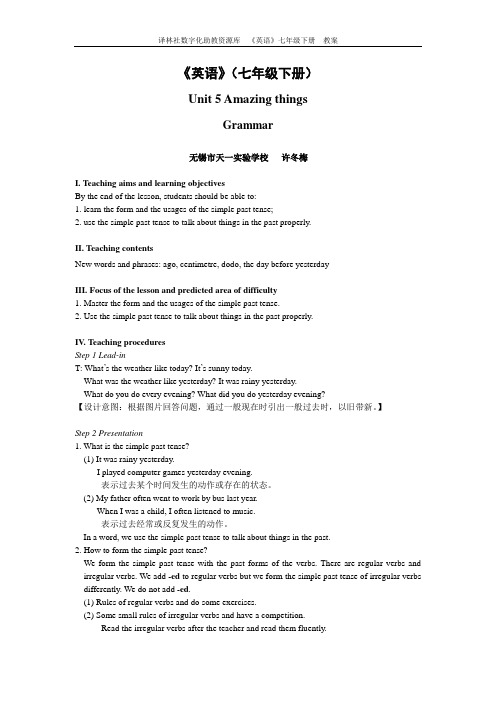
《英语》(七年级下册)Unit 5 Amazing thingsGrammar无锡市天一实验学校许冬梅I. Teaching aims and learning objectivesBy the end of the lesson, students should be able to:1. learn the form and the usages of the simple past tense;2. use the simple past tense to talk about things in the past properly.II. Teaching contentsNew words and phrases: ago, centimetre, dodo, the day before yesterdayIII. Focus of the lesson and predicted area of difficulty1. Master the form and the usages of the simple past tense.2. Use the simple past tense to talk about things in the past properly.IV. Teaching proceduresStep 1 Lead-inT: What’s the weather like today? It’s sunny today.What was the weather like yesterday? It was rainy yesterday.What do you do every evening? What did you do yesterday evening?【设计意图:根据图片回答问题,通过一般现在时引出一般过去时,以旧带新。
】Step 2 Presentation1. What is the simple past tense?(1) It was rainy yesterday.I played computer games yesterday evening.表示过去某个时间发生的动作或存在的状态。
牛津译林版英语七年级下册Unit5Grammar教学设计

3.教师针对学生可能出现的疑问和难点,进行解答和举例说明。
(三)学生小组讨论
1.教师将学生分成小组,每组根据教师提供的图片或情境,运用一般过去时进行句子构建。
- Picture 1: A girl is feeding a swan.(一个女孩在喂天鹅。)
3.教师强调本节课的重点和难点,提醒学生加强课后练习,巩固所学知识。
4.鼓励学生在日常生活中多运用英语,提高自己的语言表达能力。
五、作业布置
为了巩固本节课关于一般过去时的知识点,确保学生对所学内容有深刻的理解和掌握,特布置以下作业:
1.课本练习:完成牛津译林版英语七年级下册Unit 5 Grammar部分的相关练习,包括填空、选择和句型转换等类型。通过这些练习,帮助学生巩固动词过去式的变化规则和不规则变化,以及一般过去时的句子结构。
(四)课堂练习
1.教师设计一系列练习题,包括选择题、填空题、改错题等,让学生巩固一般过去时的知识点。
2.学生独立完成练习题,教师巡回指导,解答学生的疑问。
3.针对学生的完成情况,教师进行点评和讲解,强调易错点。
(五)总结归纳
1.教师引导学生回顾本节课所学内容,总结一般过去时的基本结构和用法。
2.邀请学生分享学习心得,讨论在句子构建和练习过程中遇到的困难和解决办法。
-预习时,请注意做好笔记,以便在课堂上提问和讨论。
5.家长参与:鼓励家长参与学生的作业过程,了解孩子在学习英语中的进步和困难。家长可以协助学生完成口语作业,或与孩子一起讨论写作作业的内容。
牛津译林版英语七年级下册Unit5Grammar教学设计
牛津译林版英语7AUnit5Grammar优秀教学案例

3.小组合作增强互动:教师设计了多种小组活动,如小组讨论、角色扮演等,让学生在小组内共同探讨情态动词"can"和"may"的用法。这种合作学习方式不仅提高了学生的学习兴趣,还培养了他们的团队协作能力和沟通能力。
(五)作业小结
1.教师布置作业,要求学生运用情态动词"can"和"may"写一篇小短文,描述自己的日常生活。
2.教师提醒学生在完成作业过程中注意语法规则,确保语言表达的准确性。
3.教师鼓励学生在课后主动复习所学知识,巩固记忆,提高语言运用能力。
五、案例亮点
1.情境创设丰富多样:本节课通过多媒体展示、图片、图表等多种形式,为学生提供了丰富的语言情境,使学生在真实的语境中感知和理解情态动词"can"和"may"的用法,提高了学生的语言运用能力。
(二)问题导向
1.教师提出引导性问题,激发学生的思考和探究欲望,引导学生自主发现和总结情态动词"can"和"may"的用法。
2.通过设置阶梯式的问题,引导学生由浅入深地理解情态动词"can"和"may"的用法,培养他们的思维能力。
3.鼓励学生提出问题,充分调动他们的学习积极性,培养他们的问题意识和解决问题的能力。
3.教师进行现场示范,用"can"和"may"进行对话,让学生跟随教师一起练习,加深对这两个情态动词用法的理解。
牛津译林版英语七下Unit 5《Amazing things》(Grammar)教学设计
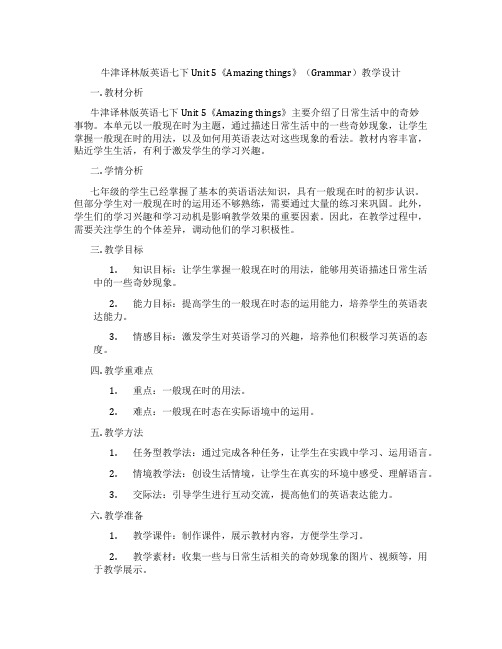
牛津译林版英语七下Unit 5《Amazing things》(Grammar)教学设计一. 教材分析牛津译林版英语七下Unit 5《Amazing things》主要介绍了日常生活中的奇妙事物。
本单元以一般现在时为主题,通过描述日常生活中的一些奇妙现象,让学生掌握一般现在时的用法,以及如何用英语表达对这些现象的看法。
教材内容丰富,贴近学生生活,有利于激发学生的学习兴趣。
二. 学情分析七年级的学生已经掌握了基本的英语语法知识,具有一般现在时的初步认识。
但部分学生对一般现在时的运用还不够熟练,需要通过大量的练习来巩固。
此外,学生们的学习兴趣和学习动机是影响教学效果的重要因素。
因此,在教学过程中,需要关注学生的个体差异,调动他们的学习积极性。
三. 教学目标1.知识目标:让学生掌握一般现在时的用法,能够用英语描述日常生活中的一些奇妙现象。
2.能力目标:提高学生的一般现在时态的运用能力,培养学生的英语表达能力。
3.情感目标:激发学生对英语学习的兴趣,培养他们积极学习英语的态度。
四. 教学重难点1.重点:一般现在时的用法。
2.难点:一般现在时态在实际语境中的运用。
五. 教学方法1.任务型教学法:通过完成各种任务,让学生在实践中学习、运用语言。
2.情境教学法:创设生活情境,让学生在真实的环境中感受、理解语言。
3.交际法:引导学生进行互动交流,提高他们的英语表达能力。
六. 教学准备1.教学课件:制作课件,展示教材内容,方便学生学习。
2.教学素材:收集一些与日常生活相关的奇妙现象的图片、视频等,用于教学展示。
3.练习题:准备一些练习题,用于巩固所学知识。
七. 教学过程1.导入(5分钟)利用课件展示一些奇妙的日常现象,如彩虹、日出等,引导学生关注本节课的主题。
然后用提问的方式引入一般现在时,让学生思考如何用英语描述这些现象。
2.呈现(10分钟)讲解一般现在时的概念,并通过示例让学生理解一般现在时的用法。
示例:描述日常生活中的习惯动作,如“I get up at 7 o’clock every morning.”。
牛津译林版七年级英语下册Unit5 Grammar优质课课件

Grammar (1)
预习
be_+v.ing
Playing Going Teaching Closing Coming Staying Watching Riding Flying putting
Running Sitting Cutting Getting Stoping Doing Making Writing Seeing Beginning
Complete the conversation
Sandy: HelloБайду номын сангаасAmy. Are you studying (study)at the moment? Amy: No, I’m not. My cousin __is_v_i_s_it_in__g_(visit) me. Sandy: Oh, really? What ___is__ he _d__o_in_g__(do) now? Amy: Well, he __is__p_l_a_y_in__g__(play) a new computer game. Sandy: ___A__re___ you ___p_la_y_i_n_g__(play) the game with him now? Amy: No, I’m not. I _a_m___w_a_i_ti_n_g__(wait) for my turn.
Look! now at present It’s … (点时间). Where’s sb.?
Listen! at the moment
right now It’s time for….
*上下文提示
Amy wants to go to Sunnyside Shopping Mall with her friends after school,but they are all busy.Help Amy write about what they are doing now.
牛津译林版七年级下册(新)英语教案7BUnit5Grammar

Every day: get up—wash face—go to school—have lunch—do sports
4. Ask Ss to use yesterday instead of every day to talk about the things they did yesterday and then write down the key words:
(3) In 1986, I studied in Jinlin Middle School.
3. Ask Ss to draw their own time line in groups of four to take turns to introduce their own experiences.
重点
To learn to talk about the things in the past with the proper forms of verbs.
难点
教学过程设计
集 体 备 课
二 次 备 课
Step 1Lead-in
1. Ask Ss: How many days are there in a week? What are they?
Step2 Presentation
1. Put a student’s bag into the desk and make a dialogue with the student:
T: Where’s the school bag?
S: It’s in the desk.
Then put the bag on the desk and ask:
Unit 5 Grammar 1教案牛津译林版七年级英语下册
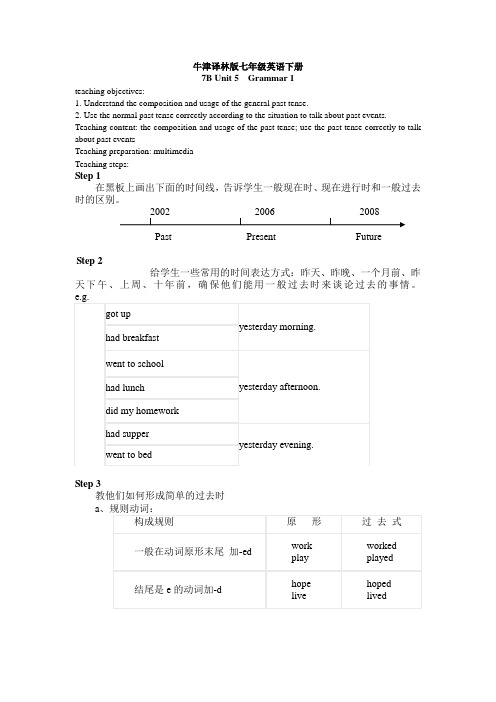
牛津译林版七年级英语下册7B Unit 5 Grammar 1teaching objectives:1. Understand the composition and usage of the general past tense.2. Use the normal past tense correctly according to the situation to talk about past events. Teaching content: the composition and usage of the past tense; use the past tense correctly to talk about past eventsTeaching preparation: multimediaTeaching steps:Step 1在黑板上画出下面的时间线,告诉学生一般现在时、现在进行时和一般过去时的区别。
Past Present FutureStep 2给学生一些常用的时间表达方式:昨天、昨晚、一个月前、昨天下午、上周、十年前,确保他们能用一般过去时来谈论过去的事情。
Step 3教他们如何形成简单的过去时a写过去。
展示以下单词,让学生将它们变成简单的过去时形式。
1. start → started2. dress → dressed3. play → played4. help → helped5. use → used6. like → liked7. look → looked8. study → studied9. plan → planned 10. cry → cried然后让学生用这些词的过去时形式填空。
请几位学生分享他们的答案。
b 、不规则动词:我们以不同的方式形成不规则动词的一般过去时。
我们不添加然后给学生一些词,把它们变成过去的形式。
如果他们不知道,他们可以查看第 112 页上的词表。
牛津译林版七年级下册unit 5《amazing things》grammar优秀教案(重点资料).doc

Unit 5 Amazing things grammar教学目标:1. 了解一般过去时的构成及用法。
2. 能根据情景用一般过去时谈论过去的事情。
教学重点:1.掌握动词过去式的构成规则。
2.掌握一般过去时的基本构成。
教学设计:Step1 Lead in1. 复习Reading部分的文章,让学生尝试用动词的正确形式填空。
It ____(be) Sunday morning. Millie and Amy ___(sit) under a big tree. They____(hear)a whisper but___(find) nothing. They___(run) away and___(meet) Amy. He ____(go) to the park and found the ghost___(be) a cat. They___(take) the cat to the animal centre.引导学生观察动词的形式。
Step 2 Presentation1. 呈现动词和它们的过去式形式turn—turned live—l ivedc ry---cried stop—stoppedbe---was/were sit—sathear—heard find---foundrun—ran meet---metgo—went take---took带领学生一起学习动词的过去式构成规律,学生先归纳,教师补充。
(1) 规则变化直接加ed以e结尾的单词加d辅音字母加y结尾的单词去y改i再加ed重读闭音节,双写最后辅音字母再加ed(2) 不规则变化不变2. 呈现以下动词,学生练习stay share chat prepare st udycarry check like pickplan invite drop3. 学习书本106页的不规则动词过去式的变化。
Step 3 Practice1. 让学生两人一组完成书本62页A部分的练习。
- 1、下载文档前请自行甄别文档内容的完整性,平台不提供额外的编辑、内容补充、找答案等附加服务。
- 2、"仅部分预览"的文档,不可在线预览部分如存在完整性等问题,可反馈申请退款(可完整预览的文档不适用该条件!)。
- 3、如文档侵犯您的权益,请联系客服反馈,我们会尽快为您处理(人工客服工作时间:9:00-18:30)。
Unit5 Grammar教案
I. Teaching aims and learning objectives
By the end of the lesson, students should be able to:
1. learn the form and the usages of the simple past tense;
2. use the simple past tense to talk about things in the past properly.
II. Teaching contents
New words and phrases: ago, centimetre, dodo, the day before yesterday
III. Focus of the lesson and predicted area of difficulty
1. Master the form and the usages of the simple past tense.
2. Use the simple past tense to talk about things in the past properly.
IV. Teaching procedures
Step 1 Lead-in
T: What’s the weather like today? It’s sunny today.
What was the weather like yesterday? It was rainy yesterday.
What do you do every evening? What did you do yesterday evening?
【设计意图:根据图片回答问题,通过一般现在时引出一般过
去时,以旧带新。
】
Step 2 Presentation
1. What is the simple past tense?
(1) It was rainy yesterday.
I played computer games yesterday evening.
表示过去某个时间发生的动作或存在的状态。
(2) My father often went to work by bus last year.
When I was a child, I often listened to music.
表示过去经常或反复发生的动作。
In a word, we use the simple past tense to talk about things in the past.
2. How to form the simple past tense?
We form the simple past tense with the past forms of the verbs. There are regular verbs andirregular verbs. We add-edto regular verbs but we form the simple past tense of irregular verbsdifferently. We do not add-ed.
(1) Rules of regular verbs and do some exercises.
(2) Some small rules of irregular verbs and have a competition.
Read the irregular verbs after the teacher and read them fluently.
Read the irregular verbs and the past forms as fast you can, and the teacher will record thetime. Let’s see who can read fastest without any mistakes.the verbs on page 62.
(4)Let’splayagame.Taketurnstoreadthesentencewiththesimplepasttenseasfastas possible.
3. When to use the simple past tense?
(1) We need some key words to help us use the simple past tense correctly.
(2) Complete the sentences. Don’t forget to circle the key words.
【设计意图:通过超链接,引导学生根据所给信息归纳一般过去时的定义、构成和时间状语,并辅以相应的练习来巩固所
学。
】
Step 3 Practice
1. Complete Millie’s diary
T:ThestudentsvisitedtheFunWorldMuseum.HereisMillie’sdiaryentry.Helphercom plete it with the simple past tense of the verbs in brackets.
2. Tell Daniel about the visit
T:Daniel didnotgo to the Fun lie istelling him aboutthe visit.HelpMillie complete the conversation. Act the dialogue out.
3. Make a survey
T: Did you go to any museums like Millie during the last May Day holiday? What did you do
during the May Day holiday? Where wereyou? How didyou feel? Let’s make a survey.Ask three of your classmates about their May Day holiday and fill in the table. You shouldspeak English when you are making your survey. Don’t forget to use the simple past tense.
4. Write a report
T: You know a lot about your classmates’holiday. Why not write a report? You can begin likethis: During the May Day holiday,…
【设计意图:由简单的书本练习到根据学生实际做调查,真正把语法运用到实际生活中,做到学以致用。
】
Step 4 Summary
巧记一般过去时
动词一般过去时,表示过去发生的事;be用was或用were,have、has变had;谓语动词过去式,过去时间做标志;一般动词加-ed,若是特殊得硬记。
V. Homework
1. Learn the irregular verbs by heart.
2. Write about your last weekend.。
